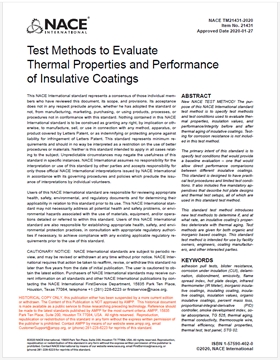Search
Test Method
View as
Sort by
Display
per page
NACE TM21431-2020, Test Methods to Evaluate Thermal Properties and Performance of Insulative Coatings
Product Number:
21431-2020
Publication Date:
2020
$179.00
New Developments in Surface Profile Measurement for Blast Cleaned Surfaces
Product Number:
41213-746-SG
Publication Date:
2013
$20.00
Novel Acrylic Epoxy Hybrid Coatings for Metal Protection Applications
Product Number:
41216-966-SG
Publication Date:
2016
$20.00
On the Topographical and Performance Effects of Underblasted and Reblasted Carbon Steel Substrate
Product Number:
51220-278-SG
Publication Date:
2020
$20.00
Paint Inspection From the Coating Manufacturer’s Perspective
Product Number:
41215-894-SG
Publication Date:
2015
$20.00
Pull-Off Adhesion Strength Testing of Lining Systems on Concrete: A Review of the Various Direct Tensil Test Methods Used for Severe Service
Product Number:
41216-992-SG
Publication Date:
2016
$20.00
Pull-Off Adhesion Testing of Coatings - Improve Your Technique
Product Number:
41215-893-SG
Publication Date:
2015
$20.00
Rapid Installation of Replacement Connection Plates on the County of Placer/Foresthill Road Bridge - A Novel Engineered Approach to a Unique Set of Challenges
Product Number:
41214-862-SG
Publication Date:
2014
$20.00
Replica Tape- Relating 3 Surface Profile Parameters to Pull-Off Adhesion
Product Number:
41215-878-SG
Publication Date:
2015
$20.00
Review Of Coating Current Test Methods For Simulating CUI Conditions And Introduction Of A New, Small Scale, Accelerated Test Method
Product Number:
51322-18173-SG
Publication Date:
2022
$20.00
Round-Robin Evaluation Of ISO 20340 Annex A Test Method
Product Number:
51316-6991-SG
ISBN:
6991 2016 CP
Publication Date:
2016
$20.00
RP-01-73-HD1973-SG, Collection and Identification of Corrosion Products-HD1973
Product Number:
RP-01-73-HD1973
Publication Date:
1973
$179.00












